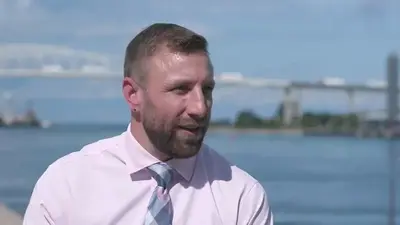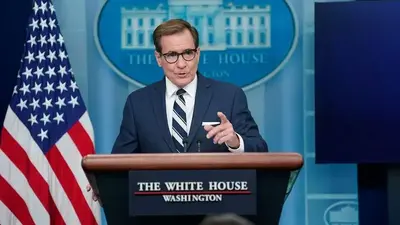Politics
After adjusting to life without student loans, payment restart brings hard choices
The pandemic pause on federal student loan payments sparked a rare opportunity for Sarah Wood and her husband: funneling the money for their monthly student loan bills to their children's education, instead of paying off their own.
Over the three-year freeze on payments, in the wake of the onset of COVID-19, the couple was able to build up college funds for their 8-year-old twin daughters.
"It was a huge, huge relief," Wood said in an interview from her Denver home. "We were able to save more aggressively for their college education, having both been through this situation -- that we want to so, so strongly avoid for them -- we were able to save more."
Wood, 40, took out $118,000 in student loans for a master's degree in education from Columbia University back in 2010. Since then, with an interest rate hovering near 8%, her loans have ballooned to $180,000 even as she's made consistent payments.
With her $440 monthly loan payment now due for the first time since March 2020, Wood said she will be forced to cut back on saving for her daughters' future.
"It's just a tightening of the belt across all areas," Wood said.
MORE: How Restarting Student Loan Payments Could Change Millions of Lives — And The Economy
She's among 28 million Americans who began repaying their federal student loan debt earlier this month. Economists say the huge wave of payments restarting won't dramatically cut into consumer spending -- but it will force millions of borrowers to readjust their budgets.
"The spillover effects to the broader economy are probably limited. It's really about the folks that are having to shell out more to make those payments -- and they have less to spend on everything else," Mark Zandi, chief economist at Moody's Analytics, said in an interview.
Even so, Zandi acknowledged that there are a lot of other headwinds at play -- the looming risk of a partial government shutdown, multiple industries on strike and stubbornly high inflation -- which, combined with the student loan restart, could create bigger challenges than they'd each pose on their own.

Retailers like Target and Best Buy have in recent months cited the restart of student loan payments as a risk to their sales in the critical holiday shopping season.
And Zandi noted the average American household is paying about $750 extra per month for the same goods and services as they were two years ago, simply because of inflation.
Combined with the average monthly student loan payment of between $200 to $300, that means Americans are spending $1,000 more "just to do what they had been doing," Zandi said.
"I think for most student loan borrowers, what it means is that they've got to make some hard choices," he said.
Faced once more with those difficult decisions, Wood, like millions of other borrowers who adjusted to life for three years without having to worry about interest or payments, feels frustrated with the student loan system.
"I certainly do want to take ownership for taking out such a large loan, but I will say it was incredibly easy. And I liken it to one of those commercials where they talk about taking medicine or something and then they quickly list all of the side effects," she said.
"I was young and naive and idealistic and wanted to change the face of education. But I quickly learned, once you got out of school and started to pay back those loans, [you] just watch that interest climb and climb and climb."
Statistics show that college costs have risen sharply in recent decades -- sometimes far outpacing many incomes. According to the Education Data Initiative, an outside research group, the average college price, including tuition, books, fees and room and board, "has more than doubled in the 21st century, with an annual growth rate of 2% over the past 10 years."
Government data supports that. The U.S. Bureau of Labor Statistics reports that consumer prices for college tuition and fees rose 63% from January 2006 to July 2016; by contrast, the mean -- or average -- personal income in the U.S. rose only 24% in that time.
In more recent periods, as consumer prices for college tuition have kept going up, personal incomes have kept better pace, according to the government data.
MORE: Student loan payments restarted on Oct. 1. Here's what to know
"I just think that we're the United States of America and we could do better," Wood said.
When it comes to her loans, Wood said she ultimately regrets them even as they helped her achieve a dream -- a painful admission.
"Internally, that makes me very sad because [my degree] is something to be proud of," she said.
Wood quit teaching after realizing that her family couldn't raise their daughters on two teachers' salaries. Despite her aspirations to work in special education with children who have autism, she now works in the accounting industry.
"It's not just the number. It's anxiety, it's taking away from what I can do for my children in the future, it's what we can do month to month. It's a constant battle," Wood said.

For Michael Lopez, a 33-year-old social worker and high school wrestling coach who lives in Anaheim, California, the last three years of paused payments have also offered him a chance to make investments he otherwise couldn't afford.
But coming out of the pause, he, too, will have to reshuffle his family's priorities.
In 2020, when mortgage rates were at an historic low, Lopez and his wife bought a fixer-upper house -- making him the first person in his family to become a homeowner, he said -- and they've been renovating it ahead of the arrival of their first child.
"I think housing is one of the most important things for folks to have stability in their lives. Quite frankly, I think we all deserve housing on some level that's adequate and safe. But it's also an investment," Lopez said.
But Lopez, like many other Americans, is leaving the pause with even more debt, rather than having used that time to pay down his loans -- a wider trend that economists say could eventually drag on consumer spending.
Lopez took on roughly $200,000 to get his undergraduate degree from a state school and his master's degree in social work. Though he's been paying his loans for about five years, with an interest rate of about 6.5%, his debt has risen to $240,000.
Lopez could qualify for the government's Public Service Loan Forgiveness program if he pays his loans for 10 years and continues to work in public service. But for now, he owes about $1,000 a month, between his and his wife's student loan bills.
That's on top of the new mortgage payment and saving up for all the costs of a new baby.
"We're really going to have to change a lot of our spending habits, and that's to make sure we can continue to just provide our basic needs comfortably," Lopez said.
Still, he hasn't considered a higher paying career merely to make ends meet a little more easily, he said, nor does he regret his loans.
"This is just too meaningful to me. I feel like it was what I was designed to do, was to help people. And so, yeah, I'm proud of it and it's exactly where I want to be," Lopez said.
But he does hope for improvements in the student loan system, the politics of which he was "more plugged into" during the pause than ever before, he said.

There were eight extensions on the loan moratorium during the last three years -- under both the Trump and Biden administrations -- as well as an attempt by President Joe Biden to give $10,000 to $20,000 in debt relief to 43 million Americans, which was rejected as overly broad by the Supreme Court last summer.
In the wake of that defeat, as a narrower "Plan B," Biden directed the Education Department to try again to cancel debt through a different law, and likely for a smaller group of people. That proposal is still being worked out.
He also established a yearlong on-ramp period, ending Sept. 2024, during which borrowers won't go into default if they miss a student loan payment -- though interest will still accrue.
And the Education Department rolled out a new repayment plan, called the SAVE Plan, which aims to lower monthly payments for some borrowers and subsidize interest so that there's less accrual over time.
Republican lawmakers have criticized Biden's push to terminate student loan obligations, calling it an abuse of presidential power and a waste of tax dollars on borrowers who refuse to do what millions of other people have managed to do: Repay their debts.
"The Biden administration is trampling the rule of law, hurting borrowers, and abusing taxpayers to chase headlines," Rep. Virginia Foxx, chairwoman of the House Education and Workforce Committee, said in one recent statement.
Lopez acknowledged that view. "Yes, there are folks who have worked for it and were able to pay. Mind you, some of those folks paid a lot less than what we're paying these days," he said. "But, you know, that's a privilege to be able to do that."
For now, both he and Wood said the White House's work won't be broad enough to help them with their payments. They’re hopeful for further reforms, they said, and in the meantime are readying themselves to take on their bills once again.
"It was very helpful at the time," Zandi, the economist, said of the student loan pause.
"Obviously, we've got to move on now," he said. "And, you know, that is not comfortable, that's painful. And that's the process we're engaged in at the current time.”
-

 Politics4h ago
Politics4h agoHere Are the Historic Wins of the 2024 Election
-

 Politics4h ago
Politics4h agoWhat Trump’s Win Means for His Legal Cases
-

 Politics10h ago
Politics10h agoHow the 10 States’ Abortion Ballot Initiatives Fared in the 2024 Election
-

 Politics10h ago
Politics10h agoHow World Leaders Are Reacting to Trump Winning the U.S. Presidential Election
-

 Politics15h ago
Politics15h agoDonald Trump Wins 2024 Election
-

 Politics15h ago
Politics15h agoTrump Declares Election Victory in Speech to Supporters
-

 Politics17h ago
Politics17h agoAmerica’s glass ceiling remains − here are some of the reasons why a woman may have once again lost the presidency
-

 Politics17h ago
Politics17h agoBallot measures to legalize recreational use of cannabis fail in Florida, North Dakota and South Dakota



























